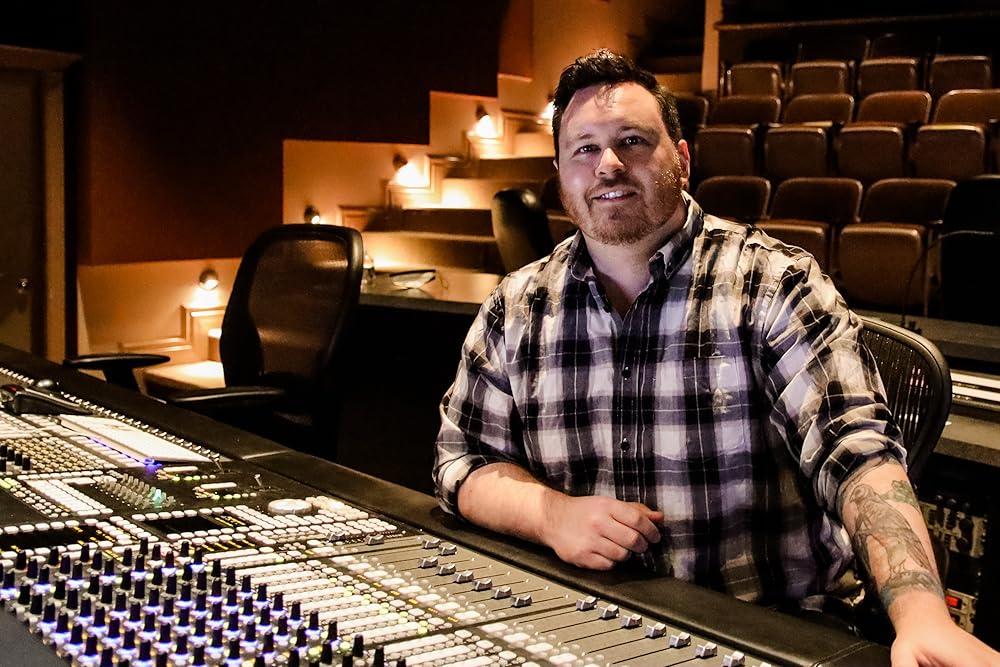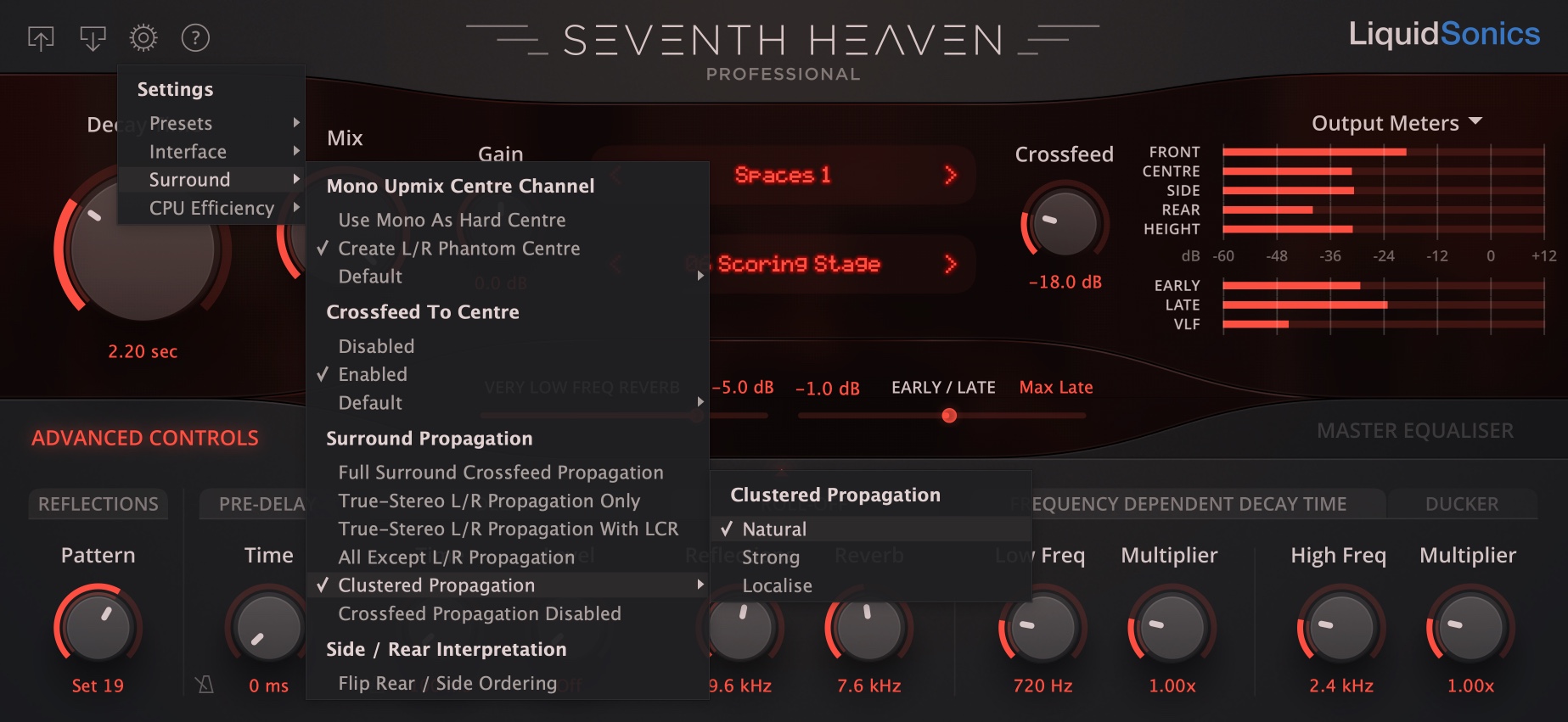
 LiquidSonics recently introduced new surround clustered propagation modes in Cinematic Rooms Professional (v1.3.9), Seventh Heaven Professional (v1.5.7), and Lustrous Plates Surround (v1.3.7), designed to deliver a natural and spatially anchored reverb experience when mixing in immersive.
LiquidSonics recently introduced new surround clustered propagation modes in Cinematic Rooms Professional (v1.3.9), Seventh Heaven Professional (v1.5.7), and Lustrous Plates Surround (v1.3.7), designed to deliver a natural and spatially anchored reverb experience when mixing in immersive.
In post-production and spatial mixing workflows, maintaining precise pan tracking (ensuring that reverb energy follows the panning movement and placement of a sound within the surround field) is critical to enhancing realism and preserving focus. Reverbs have many different ways of achieving this, but no single solution or approach is optimal in every scenario, meaning a variety of modes are highly valuable.
Unlike traditional propagation schemes that distribute reflections and late energy evenly across all channels, clustered propagation allows the reflected and reverberant energy to remain more closely tied to the originating channel and its neighbours in the surround field. This means that as sound travels through the virtual space, it retains a closer association with its panned position, so the source remains spatially focused while still surrounded by a believable sense of space and ambience.
In the images below, we pan a mono source around a 7.1.6 bed. See how, with clustered propagation, it is easy to ensure that the level of the reverb is dependent on the input source position, clearly following the panner. In Cinematic Rooms Professional, it is even possible to control this independently for the reflections and reverb, a unique capability amongst immersive reverbs on the market today.
 Clustered propagation helps preserve directional intent and clarity in immersive formats where complex panning or moving sources are common. Whether applied to enhancing the natural realism of environments in Cinematic Rooms Professional for post production and score, or when layering beautiful musical reverbs in Seventh Heaven Professional, or controlling the vintage spatial tone of Lustrous Plates Surround, clustered propagation provides mixers with refined control over crossfeed focus, allowing reverbs to sound expansive without losing their connection to the mix position.
Clustered propagation helps preserve directional intent and clarity in immersive formats where complex panning or moving sources are common. Whether applied to enhancing the natural realism of environments in Cinematic Rooms Professional for post production and score, or when layering beautiful musical reverbs in Seventh Heaven Professional, or controlling the vintage spatial tone of Lustrous Plates Surround, clustered propagation provides mixers with refined control over crossfeed focus, allowing reverbs to sound expansive without losing their connection to the mix position.
Cinematic Rooms Professional and Lustrous Plates Surround also include modes that also influence the time delay of the crossfeeds in addition to the level. This allows timing dependent clustering, for instance a sound that presents on the front left would take longer to propagate to the left side than the left rear surround, and further still to the right rear surround. The use of the variable crossfeed delays enhances the perception of size in medium to large rooms and in orchestral mixes benefits the overall sense of immersion in the space.
You can get the updates from the LiquidSonics software downloads page, and for a deeper dive, check out section 5 of the recently updated surround propagation modes article, where you can learn about this and all of the other propagation modes.
The feature was developed with the guidance of LA-based re-recording mixer and supervising sound editor Bret Killoran, with whom we join for a quick Q&A about why the capability is so helpful for his workflow…

Q) You reached out to LiquidSonics after speaking with Marti Humphrey about some of your reverb workflow requirements. Marti is a good friend to LiquidSonics and helped to put us in touch with each other; he was incredibly helpful during the design phase of Cinematic Rooms, how do you both know each other?
A) When I moved from Toronto to LA, I had reached out to Marti since he has such an active presence on forums, and he was so welcoming and helped me get integrated into the LA sound community down here. Nothing but nice things to say about Marti!
Q) Perhaps you could talk us through the requirements that led to us implementing this exciting new feature.
A) I had been constantly changing my approach to reverbs in dialogue mixing over the past 10 years because I’ve never been fully happy with surround reverbs and the balance between the screen channels and the surrounds. Whenever I turned the reverb up enough that I liked how it sounded on the screen and how it glued the dialogue to the scene, I felt it got too loud in the surrounds and became a distraction and disassociated from the dialogue. To me, this is the challenge of immersive mixing in general when working with a static 2D image.
The simple fix was to use the surround plane controls on Cinematic Rooms Professional to dial down the surround level. While this worked for the dialogue that’s panned center, once you start panning sounds, the reverb no longer feels correct to me as I’m hearing too much of it in opposite channels from the source, and I completely lose localization. This is especially noticeable in panned FX/Foley/BGs, as adding enough reverb to make drier sounds fit in the room on screen, I find all the channels just start playing too much reverb, and I lose the clarity I’m trying to achieve. This was causing me to use a more complex setup of mono and surround verbs in order to achieve that balance.
After talking with [LiquidSonics founder] Matt and explaining my idea, he came up with the term “cluster”, which explains how the reverb is clustered around the input channel and gets lower in the channels furthest away. So now, sounds panned to the center channel will sound similar to the static mix setting mentioned above, but if I need to pan something hard into the left surround for effect, the reverb “cluster” will move around the left surround as well without me needing to automate the reverb.
It’s really rooting the dialogue to the screen in a positive way, and in one of my first tests of this version, I was automating the cluster using the crossfeed control in Cinematic Rooms Professional. When a character yelled, I “bloomed” the sound into the surrounds more, which really felt like this character excited the room. By automating the feeling of the cluster, it didn’t just make the dialogue more wet, but instead kept the reverb level roughly the same and enhanced the sense of authority of this character’s yell.
Cinematic Rooms Professional gives such deep control over both the early reflections and the reverberation, and to me, that’s critical, as it’s not just about reverb levels, but about reverb interaction, which feels much more natural. This is the only reverb that I know of that does this. The Audio Ease stuff has cloud size, but not with independent early reflections and tail controls, which is what makes this verb really special.
I can’t say enough good things about the flexibility this brings to my workflow. It has simplified my reverb approach, and when things are simpler, I have more time to make other creative decisions, and maximizing my time to be creative is the ultimate goal!
Q) Have you been using this for any other kinds of environments besides rooms?
A) I have been finding great success with exterior sounds, especially when using the more extreme “localise” propagation setting with the early reflections. I can add a subtle slap and sense of air around the dialogue without it becoming noticeable in the surrounds, but can give it a little burst into the room when needed. It’s fantastic.
Q) So what’s next up that you’ll be needing clustered propagation to help out with?
A) I’m jumping into a sci-fi film next, and it takes place in a variety of different futuristic interiors, so I’ll really run it through its paces there, especially in a genre where reverb can be a little more present. The movie I’m premixing at the moment is a horror/haunting movie and most of it takes place in the same house, so I found a setting I like and I’ve really bundled the early reflections to the front wall and around the source, but the tail I have -9 dB on the crossfeed which keeps some signal in the surrounds, and it feels really natural and sits in the same place as my backgrounds, so there’s a really nice cohesion to everything.
This is really, really awesome. I feel like I finally have a reverb plugin that can replace all other ones since I can do everything I want now!!
